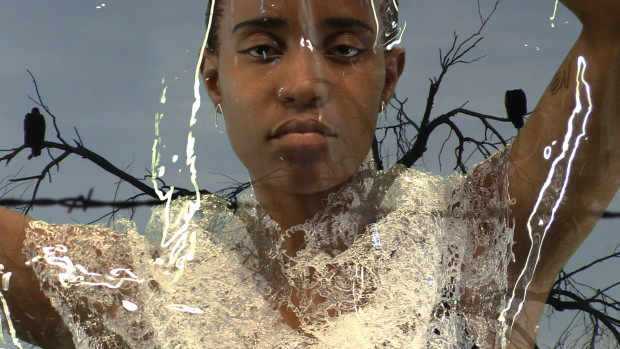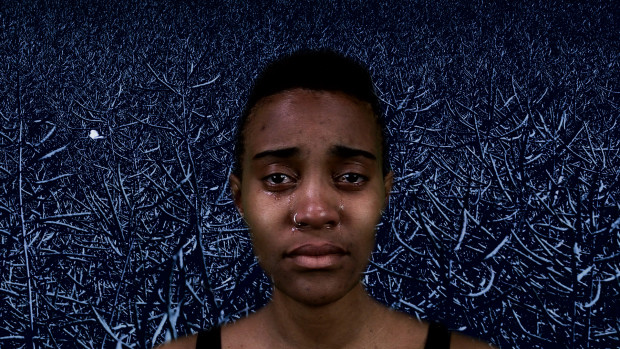U5 – House of Sentiments – Part 2: Talking about space, collaboration and process
The multi-dimensional artwork “House of Sentiments” by the Zurich based artist collective U5 is an installation in several parts. It confronts the visitors with the ways in which virtual, architectural and emotional realities combine and influence one another. “House of Sentiments” consists of a 4-channel video installation in which four mood images (sad, angry, calm, happy) combined with four colors affect one’s own emotional economy. The second part is a walk-in interactive sculpture where the visitors are confronted with themselves in the wide space of digital reality.
Khensani de Klerk is the focal character of the 4-channel-video. She is an architectural designer based in Cape Town, South Africa and founder and co-director of the intersectional collective Matri-Archi, that brings POC (People of Color) African women together for the empowerment and development of African cities and spatial education. Sarah Merten talks with Khensani de Klerk and U5 about the affective potentials of “House of Sentiments” and the working process of their collaboration.

U5, House of Sentiments (video still), 2018, 4-channel video installation, République Géniale, Kunstmuseum Bern, © U5
Sarah Merten: For me, “House of Sentiments” becomes meaningful in different ways. Especially when I see the video, every time different thoughts and emotional states arise. When I was sitting in the pillows, surrounded by the room-sized images and the sound, looking at Khensanis face, I suddenly wasn’t sure who is the one gazing. I felt connected – emotionally compassionate – but also distant because it is a larger-than-life projection. I also became aware of questions about identity and representation politics in the museum’s context, because – at least in middle-European museums –People of Color are still rarely present. I realized that this video is able to trigger a lot of different feelings and discussions. So, I wonder where you see the potential of “House of Sentiments”?
Khensani de Klerk: The work has the opportunity to evoke so much from different people depending on who’s seeing it, when they’re seeing it, and on the preconceived notions they have behind them. Everyone has a different sentiment, but it’s emplaced in the same room. Some of the sentiments may be conflicting, some of them may be the same. That’s the interesting part. Even though it has these four colors, these four ideas of emotions, or let’s say four “rooms”, you as a viewer have the instinctive capability to find the metaphorical colors in between.
U5: To provoke different meanings, thoughts and ways of discussions is one aim of the work.
Sarah Merten: So, how was it for you, Khensani, to see the final state of the video as a product of your collaboration in the exhibition, which is, I guess, a different experience than to see it on a screen?
Khensani de Klerk: First, it’s always uncomfortable seeing yourself. But what I really enjoy is the fact that you are always unaware of what is going to come next. It is difficult to orientate in the narrative of the video even if you are aware of the four “rooms”. When I’m looking left, I have missed a specific amount of time on the other side of my pupil’s vision. And so, every time I come to the “House of Sentiments”, it is a different order of how I experience it. It’s a constant renewal. This also can engage with the fact, that I don’t see it as a product, but as a reflection of the recording process. Of course, the audience obviously doesn’t have that kind of insight…
Sarah Merten: I’d like to hear more about the collaboration between you and U5. How did it come to it? I’m wondering, because you’re not a performer or an actress by profession, but an architectural designer.
Khensani de Klerk: It was a series of lucky events and architecture plays a huge role in it. At the time we met – I was living in Zurich for one year – I was working together with a filmmaker on a film for an architecture firm. I personally was also experimenting with what it means to articulate inhabiting architectural space through film. It was an exploration and discovery which was also underpinned by the work of our collective Matri-Archi. There, we have huge elements of not necessarily depicting architectural space as what it is formally, but also what it is emotionally. Therefore, the collaboration with U5 wasn’t unfamiliar at all.
Sarah Merten: Can you give me some more insights in the working process, you referred to? The crucial thing with art in general is, that in the presentation context, the working process hides behind the display situation, unless the artwork itself deals with it.
Khensani de Klerk: We first met in the work space where I was working at and we were somehow connected through the film making. U5 told me about the project in a very early conceptional state. It was really just a description of a potential thing that we could create together. The project wasn’t even yet titled “House of Sentiments”. I expressed immediate interest because it was, like I have just described, the space on what I was thinking and how I was feeling at the time. We then met in their atelier and discussed a bit, and automatically our personalities – at least in terms from a work ethic – kind have clicked. It was a very quick process of trusting. We then created a Whatsapp group exchanged a lot of visual thoughts and ideas. It was like an exploration really and it was an iterative process, working back and forth constantly. We spent a lot of time together which created a great space and level of comfort. To me, it didn’t feel like a performance. It is not performance in fact, because a lot of those emotions are quite real. To really get to be able to confront the emotions was a very therapeutic as well a cathartic process. And then we also went to Venice together…

U5, House of Sentiments (video still), 2018, 4-channel video installation, République Géniale, Kunstmuseum Bern, © U5
U5: Yeah, it was very spontaneous, though! It was the time of the Venice Architecture Biennale. We booked a room three month before without knowing who will finally need it and then it was us.
Khensani de Klerk: It was an incredible time. We stayed together in this one room, which was very small. It was a little trashy, to be honest, but it was the perfect location. To be able to sleep in the same room and to share the same living space made me feel really proud of the collective we’ve had become. We even did some filming in this room with the green duvet, used as a green screen. For me that is really the peak of the process, because it’s something that I cherish as a memory in itself.
Sarah Merten: It sounds like lots of fun. But it also sounds like a shared experience that goes beyond the scope of the artwork. Of course, the piece is present somewhere because it’s the occasion of your collaboration, but in this very moment you just described, it’s not about it.
Khensani de Klerk: Yes, I definitely agree.
Sarah Merten: I’d like to come back to your work with Matri-Archi. Can you tell me more about this project? As you said, Matri-Archi, it is not at all dealing with architectural space only. So, I wonder, if and how you probably draw a line from Matri-Archi to “House of Sentiments”?
Khensani de Klerk: I co-direct Matri-Archi together with Solange Mbanefo, who is an architect based in Basel. But Matri-Archi is a collective of ten people all over the world. Some of us have never even met, but we work really close with one another. Matri-Archi as a collective exists online only and in light of the post-industrial revolution it is very forth thinking in experimenting with the interface between digital media and architecture, or let’s say physical space. To transcend the normality and often banality of architecture, to think about how we can transcend physical space through digital media is the predominant link between Matri-Archi and “House of Sentiments”. And also, to provoke conflicting standards and norms in which people perceive the people around them. The world is a very contested space in terms of identity politics, but when you look at the video, it shifts the expectations of what that means. It puts the viewer in a position of their own way of rethinking these preconceived notions and norms. So, it is an empowering, interactive piece that is not stagnant as a house normally is. And it’s engaging. That’s also what Matri-Archi explicitly seeks to do.
U5: Actually, one rule for our work is to never finish anything, but to keep the process going and also to include other people to it. This is what interests us in general. Due to technical developments but also due to postmodern turns, the state of just looking at an artwork without engaging in some kind of way is over, because for instance a video affects you. There is no objective point of view anymore.
Veröffentlicht unter Allgemein, République Géniale
Schlagwörter: Künstlergespräch, République Géniale, Robert Filliou, Videokunst

